The Oregon Electric Railway (OE) was an interurban railroad line in the U.S. state of Oregon that linked Portland to Eugene.
The Oregon Electric Railway (OE) was an interurban railroad line in the U.S. state of Oregon that linked Portland to Eugene.
Service from Portland to Salem began in January 1908. [1] The Spokane, Portland and Seattle Railway purchased the system in 1910, and extended service to Eugene in 1912. After the company requested, and received, permission from the Interstate Commerce Commission to abandon a section of line in Portland because of declining ridership and worsening traffic congestion. [2] Passenger service was cut back to Front and Jefferson streets the following day, and OE moved its ticket office to that location. [3] The tracks along 10th and Salmon streets were abandoned and soon removed. [4] Regular passenger service in the Willamette Valley ended in May 1933.
Electrified freight service continued until dieselization in 1945. [5] The Oregon Electric was merged into the new Burlington Northern Railroad in 1970. [6] The Burlington Northern operated the last freight train on the ex-OE Forest Grove branch on December 31, 1994, in preparation for the construction of Westside MAX, part of the TriMet light rail system.
The tracks run parallel to the main modern Union Pacific line between Portland and Eugene, used for freight and passenger service. The OE line is to the west, closely following the Willamette River. [7] In the 2000s, the line has been under consideration as an alternative for Amtrak's Cascades and Coast Starlight passenger lines. Removing passenger service from the clogged Union Pacific track would improve the timeliness of the trains, permit higher capacity, and allow higher-speed travel, peaking at 110 miles per hour (180 km/h). [7]
The right-of-way between Portland and Tigard has since been abandoned. From the North Bank Depot, it followed 10th Avenue, Salmon Street, and West Bank of the Willamette River. Portions of the right-of-way between the Southwest Waterfront and Multnomah Boulevard are currently under Interstate 5.




In order from north to south
In order from west to east
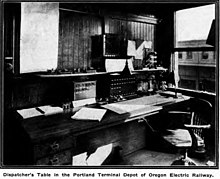
In order from west to east

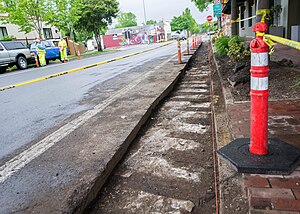
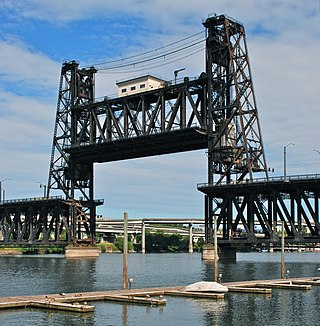
The Steel Bridge is a through truss, double-deck vertical-lift bridge across the Willamette River in Portland, Oregon, United States, opened in 1912. Its lower deck carries railroad and bicycle/pedestrian traffic, while the upper deck carries road traffic, and light rail (MAX), making the bridge one of the most multimodal in the world. It is the only double-deck bridge with independent lifts in the world and the second oldest vertical-lift bridge in North America, after the nearby Hawthorne Bridge. The bridge links the Rose Quarter and Lloyd District in the east to Old Town Chinatown neighborhood in the west.
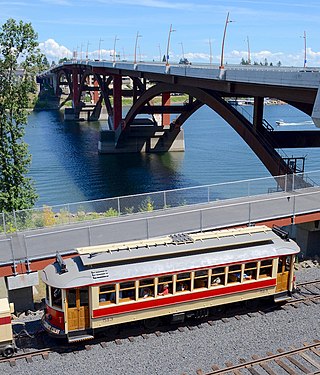
The Willamette Shore Trolley is a heritage railroad or heritage streetcar that operates along the west bank of the Willamette River between Portland and Lake Oswego in the U.S. state of Oregon. The right-of-way is owned by a group of local-area governments who purchased it in 1988 in order to preserve it for potential future rail transit. Streetcar excursion service began operating on a trial basis in 1987, lasting about three months, and regular operation on a long-term basis began in 1990. The Oregon Electric Railway Historical Society has been the line's operator since 1995.

The BNSF Railway Bridge 5.1, also known as the St. Johns Railroad Bridge or the Willamette River Railroad Bridge, is a through truss railway bridge with a vertical lift that spans the Willamette River in Portland, Oregon, United States. Built by the Spokane, Portland and Seattle Railway (SP&S) and completed in 1908, it was originally a swing-span bridge, and its swing-span section was the longest in the world at the time. However, 81 years later the main span was converted from a swing-type to a vertical-lift type, in order to widen the navigation channel. The lift span is one of the highest and longest in the world. The bridge consists of five sections, with the two sections closest to the bank on each side fixed.

Portland Union Station is a train station in Portland, Oregon, United States, situated near the western shore of the Willamette River in Old Town Chinatown. It serves as an intermediate stop for Amtrak's Cascades and Coast Starlight routes and, along with King Street Station in Seattle, is one of two western termini of the Empire Builder. The station is a major transport hub for the Portland metropolitan area with connections to MAX Light Rail, the Portland Streetcar, and local and intercity bus services. The station building contains Wilf's Restaurant & Bar on the ground level and offices on the upper floors. It also has Amtrak's first Metropolitan Lounge on the West Coast, which is reserved for first-class sleeping car and business-class passengers.

The Portland and Western Railroad is a 516-mile (830 km) Class II railroad serving the U.S. state of Oregon, and is a wholly owned subsidiary of shortline and regional railroad holding company Genesee & Wyoming Inc. The PNWR includes a subsidiary, the Willamette and Pacific Railroad.

The Westside Express Service (WES) is a commuter rail line in the U.S. state of Oregon serving parts of Washington and Clackamas counties in the Portland metropolitan area. Owned by TriMet and operated by Portland & Western Railroad (P&W), the line is 14.7 miles (23.7 km) long and travels north–south from Beaverton to Wilsonville along a route just west of Oregon Highway 217 and Interstate 5 (I-5). WES consists of five stations and connects with MAX Light Rail at Beaverton Transit Center. Service operates on a 45-minute headway on weekdays during the morning and evening rush hours. In Spring 2022, WES saw a daily ridership of 420 passengers or about 109,000 riders annually.
Rail transportation is an important element of the transportation network in the U.S. state of Oregon. Rail transportation has existed in Oregon in some form since 1855, and the state was a pioneer in development of electric railway systems. While the automobile has displaced many uses of rail in the state, rail remains a key means of moving passengers and freight, both within the state and to points beyond its borders.

The Wilsonville railroad bridge is a steel truss bridge that crosses the Willamette River at Wilsonville, Oregon, United States. This 1,220-foot-long (370 m) structure was finished in 1975 to replace a 1907 bridge at the same location and carries rail traffic for the Portland and Western Railroad. The original bridge was built to carry the Oregon Electric Railway across the river near the Boones Ferry.
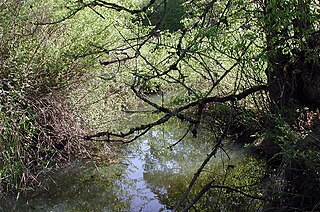
Fanno Creek is a 15-mile (24 km) tributary of the Tualatin River in the U.S. state of Oregon. Part of the drainage basin of the Columbia River, its watershed covers about 32 square miles (83 km2) in Multnomah, Washington, and Clackamas counties, including about 7 square miles (18 km2) within the Portland city limits.

Tualatin is a train station in Tualatin, Oregon, United States, served by TriMet as part of WES Commuter Rail. Situated next to Hedges Green Shopping Center on Southwest Boones Ferry Road, it is the fourth station southbound on the commuter rail line, which operates between Beaverton and Wilsonville in the Portland metropolitan area's Washington County. The station was approved in 2004 as part of the Washington County Commuter Rail Project, but construction was delayed following a dispute with its location and the amount of available parking. A compromise was eventually reached, and it was completed in time for the line's opening in 2009. The station includes a 129-space park and ride and connections to the Tualatin Shuttle and TriMet bus routes 76–Hall/Greenburg and 97–Tualatin–Sherwood Rd. WES connects with the Blue and Red lines of MAX Light Rail at Beaverton Transit Center.
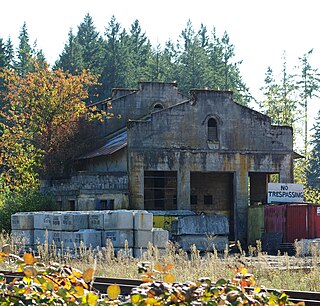
Tonquin is an unincorporated locale in Washington County, Oregon, United States.

The Southern Pacific Red Electric Lines, also known simply as the Red Electric, was a network of interurban passenger train services operated by the Southern Pacific Railroad in the Willamette Valley of the U.S. state of Oregon from 1914 to 1929. The service got its name from the bright red color of its cars. Despite its short history, among West Coast interurbans it was unique, and it was considered the finest such system in the Pacific Northwest. It was the only major electric interurban railroad converted from steam to electric passenger use. It was also one of few systems using all-steel equipment, and one of the largest 1500-volt systems in the country.

The Pengra Pass rail route, also known as the Natron Cutoff, the Cascade Subdivision, or the Cascade Line, is a Union Pacific Railroad line connecting Eugene, Oregon, with Klamath Falls, Oregon. Construction of the line began in 1905 and was completed in the mid-1920s. Its name denotes a mountain pass on the Lane County–Klamath County boundary in the Cascade Mountains of Oregon, about 1.5 miles (2.4 km) from Willamette Pass. The line heads southeast from Eugene, up the Cascades and over Pengra Pass, then southward beside U.S. Route 97 to Klamath Falls, where it splits in two, each track continuing into California. The route has at least 22 tunnels, several snow sheds and multiple bridges across canyons.
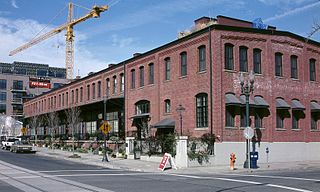
The North Bank Depot Buildings, in central Portland, Oregon, United States, are a pair of buildings formerly used as a freight warehouse and passenger terminal for the Spokane, Portland and Seattle Railway (SP&S). Formed in 1905, the SP&S was commonly known as the North Bank Road during the period in which these buildings were in use. The Portland buildings' passenger facilities were also used by the Oregon Electric Railway after that railway was acquired by the SP&S. Located in what is now known as the Pearl District, the buildings were listed on the National Register of Historic Places in 1996. They were in use by the SP&S and its successor, Burlington Northern Railroad, from 1908 until the 1980s. Only the east building was used as a passenger station, and this usage lasted from 1908 until 1931.

The Portland General Electric Company Station "L" Group in southeast Portland in the U.S. state of Oregon was a cluster of six industrial buildings listed on the National Register of Historic Places. Built between 1910 and 1929 by Portland General Electric (PGE), it was added to the register in 1985. In 1986, PGE gave Station L and 18.5 acres (7.5 ha) of land to the Oregon Museum of Science and Industry (OMSI). The Station L turbine is a central feature of OMSI's Turbine Hall. The complex was listed on the National Register in 1985, and was delisted in 2020.

Tualatin Valley Fire & Rescue (TVF&R) is a special-purpose government fire fighting and emergency services district in the Portland metropolitan area of Oregon. Established in 1989 with a merger between Washington County Fire District 1 and the Tualatin Rural Fire Protection District, it primarily provides fire and emergency medical services in eastern Washington County, but also provides services in neighboring Multnomah, Clackamas, and Yamhill counties. It serves unincorporated areas along with the cities of Beaverton, Tigard, Tualatin, West Linn, Wilsonville, and Sherwood, among others. With over 400 firefighters and 27 fire stations, the district is the second largest fire department in the state and has an annual budget of $197 million.
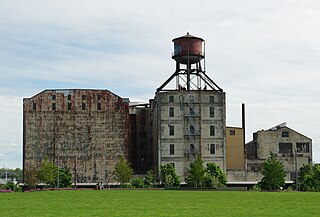
The Centennial Mills, originally known as the Crown Mills, is a complex of twelve buildings along the Willamette River in Portland, Oregon's Pearl District, in the United States. The Portland Development Commission has owned Centennial Mills since 2000. The buildings are slated for demolition, except for the flour and feed mill buildings. Between Summer 2015 and Fall 2016, most of the buildings on the property was demolished.

The Forest Grove branch is an abandoned railway line in the state of Oregon, in the United States. It was built by the Oregon Electric Railway and ran 19.1 miles (30.7 km) from Garden Home to Forest Grove via Beaverton and Hillsboro. The MAX Blue Line uses part of the right-of-way between Beaverton and Hillsboro.
The Newberg branch is a railway line in the state of Oregon, in the United States. It runs 36 miles (58 km) from Portland to a junction with the West Side branch west of Saint Joseph. It was originally built by the Portland and Willamette Valley Railway, a predecessor of the Southern Pacific Transportation Company.